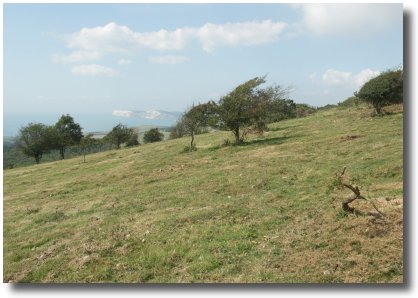Wight Conservation - Chalk Grassland
 Chalk grassland is the name given to the specific community of plants - both
grasses and wildflowers (herbs) - which is able to tolerate the alkaline soil
conditions found in areas where the underlying bedrock is chalk. A range of
distinctive invertebrates are also associated with the habitat, including many
which are not able to survive anywhere else. Chalk grassland is the name given to the specific community of plants - both
grasses and wildflowers (herbs) - which is able to tolerate the alkaline soil
conditions found in areas where the underlying bedrock is chalk. A range of
distinctive invertebrates are also associated with the habitat, including many
which are not able to survive anywhere else.
This community is only found where the grassland has not be agriculturally
"improved" by the addition of farmyard manure or chemical fertilisers, or the
use of herbicides. Where this has happened, the faster growing grasses tend to
thrive at the expense of the less competitive species and consequently the
diverse mix of grasses and wildflowers is destroyed.
In recent years much of the chalk grassland in the UK has been lost, either due
to agricultural improvement or because areas have been ploughed up to provide
more arable land. What remains tends to be found on steep slopes where the
topography of the land has made access with machinery difficult, although even
these areas may have had fertiliser applied from the air in the 1950’s. Thus our
remaining chalk grassland has been identified as a
UK Biodiversity Action Plan
priority habitat , and many areas are given additional protection from future
mismanagement by being designated as Sites of Special Scientific Interest.
 Herb-rich chalk grassland generally requires either continuous light grazing or
heavier periodic grazing to keep the sward height down and prevent the
encroachment of coarse grasses and scrub. Sheep and/or cattle are usually the
most effective grazing stock for a managed site. Decisions made regarding the
type of stock selected and the timing and level of grazing most desirable for
the nature conservation interest of a site are dependant upon the plants and
butterflies known to be present and the character of the site itself. It is
important that some structure is retained within the sward for the insects and
other interests, but the grazing must be adequate over successive years to
ensure that scrub doesn’t encroach and that the coarse grasses don’t become too
dominant. Herb-rich chalk grassland generally requires either continuous light grazing or
heavier periodic grazing to keep the sward height down and prevent the
encroachment of coarse grasses and scrub. Sheep and/or cattle are usually the
most effective grazing stock for a managed site. Decisions made regarding the
type of stock selected and the timing and level of grazing most desirable for
the nature conservation interest of a site are dependant upon the plants and
butterflies known to be present and the character of the site itself. It is
important that some structure is retained within the sward for the insects and
other interests, but the grazing must be adequate over successive years to
ensure that scrub doesn’t encroach and that the coarse grasses don’t become too
dominant.
Wight Conservation owns over 110 hectares (270 acres) of chalk grassland at
Wroxall Manor Farm (76 hectares / 188 acres, of which have been re-created on
ex-arable land), and just over 8 hectares (almost 20 acres) at Coombe Down . A
further 23 hectares (57 acres) of semi-improved grassland over chalk on
Brighstone Down is now being managed without fertilisers or herbicides in an
effort to “starve out” the coarser more competitive species and so encourage
other grasses and wildflowers to colonise the site again. There is also an area
of just over 18 hectares (45 acres) on Mottistone Down belonging to Wight
Conservation which is a mosaic of unimproved chalk grassland (almost 6 hectares
/ 15 acres of which is
SSSI
), scrub and cleared ground which was, until
recently, forestry plantation..
Dr Jemma Batten
|